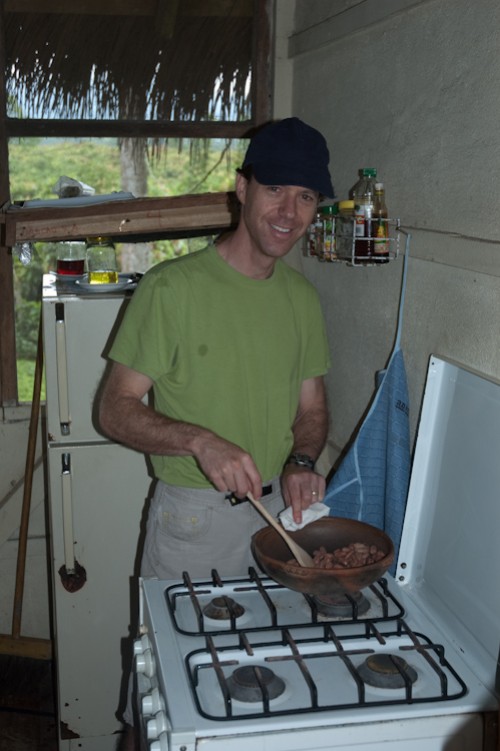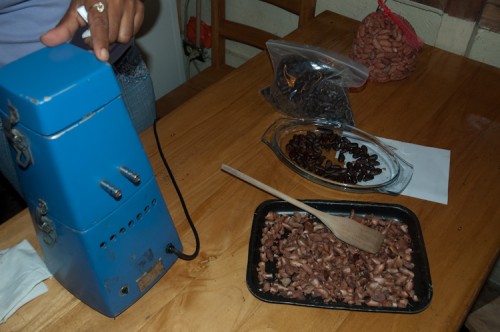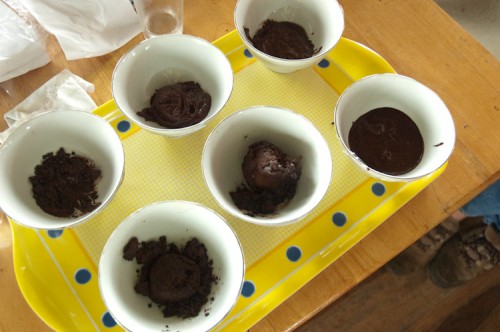Interview with Jeffrey Stern, Chocolatier and Chocolate Advocate in Quito, Ecuador, final
Jeffrey Stern is a chocolatier, chocolate advocate, entrepreneur, and blogger based in Quito, Ecuador. I recently asked Jeff to answer a long list of questions about his life and work, and he was kind enough to oblige. The first and second parts of the interview can be read here and here. Below, in the third part of the interview, Jeff shares some final thoughts on the role of chocolate in his life, working with chocolate, learning more about it, and starting a chocolate business in a cacao growing country.
Interview with Jeffrey Stern, Part 3, November 2011
Carla Martin (CDM): What are some of your most memorable experiences related to chocolate?
Jeffrey Stern (JM): I don´t have any really strong childhood memories of chocolate — I did always like to cook, but didn´t really figure that out until I was in my late twenties. I was just the regular American kid who grew up eating Hershey bars, Reese´s Peanut Butter Cups, Snickers, and Milky Way. I always had an affinity for chocolate but not an obsession.
Once I finished culinary school and started playing around with chocolate, I saw that there was so much more I could do with it. Another turning point for me was the day when I realized I could almost just look at chocolate and see if it was properly tempered/crystallized. Having that familiarity from working with it day in/day out, when you can temper on-call with no thermometer, no guidance, no reference points except what’s in your own mind, that’s a nice achievement. Once you have that, you can do a whole lot more because you don’t have to doubt if it’s properly tempered, you don’t have to check, you can just start making stuff. Then from there, once you realize how crystallization also applies to ganaches, things just get a lot easier to make.
I think my most memorable experience was tasting cacao liquors on the farm a few years ago, here in Ecuador. I had no idea there were such major distinctions between different beans based on fermentation alone. All the bean batches had been unscientifically roasted in a traditional clay pot, then ground there on the spot in a lab grinder for us to taste. Photos below.
CDM: What are your favorite things about working with chocolate?
JS: I like working with chocolate because it demands patience, you can’t rush it, and you have to pay attention to what you’re doing. My favorite activity in the shop and the one I find the most “zen” is running the enrober. You get the chocolate in temper, tweak all the adjustments on the enrober, and then just start running pieces through it. They come off, you apply transfers or fork designs or toppings, and then you just do it again. With my employee in the shop, we can get into a groove where no one is talking, we are just running batch after batch of pieces through the machine, and these beautiful little gems are being produced one after another after another. And suddenly an hour has passed and there are tables full of chocolate everywhere, and you line them up on a sheet pan and into the speed rack and just keep going.
CDM: What role does chocolate play in your life outside of work? (e.g. How is chocolate valued in your life or adding value to your life? What about it is rewarding? Is it a part of your family life?)
JS: I would say now that I have been so involved in chocolate here for so much time, chocolate and work have meshed as one. Through blogging about chocolate and my web presence, I am getting an increasing number of tourists from abroad coming to visit the workshop, as well as tour operators contacting me for activities. I always have chocolate around at home, but usually just solid bars or mendiants with dried fruits and nuts. My kids love all things chocolate, and fortunately they prefer dark over milk! I have also taken the kids to cacao plantations with me, and to them, it´s not some mystery or something strange where chocolate comes from. It´s very commonplace for them.
CDM: What would you recommend that folks new to exploring fine or craft chocolate do to learn more?
JS: Besides tasting as many different chocolates as possible, I would recommend trying to visit a cacao growing country. Don’t just go to the country and visit a cooperative or grower, but stay a few days on the ground, see what goes on, talk to the farmers. Visit chocolate factories, chocolate makers. Get immersed. That’s what I try to offer people who come on tours to Ecuador — to not just taste chocolate, but get a real taste for the people, country, and heritage behind chocolate in the country of origin.
CDM: If other groups of people were interested in forming companies similar to yours, what advice would you offer to them?
JS: The operations and logistics are easy; anyone can learn how to do those parts and while there is not a lot of guidance out there, it’s not difficult. But if you plan to set up a business in a cacao producing country, you’ll probably find that most people in the country are not that interested in chocolate itself — because most of it, in the form of beans, is being exported. That’s just a fact of the developing world and commodities-based economies. There is a deep, difficult chasm to cross if you want to export chocolate from say Ecuador, to the US, and not have it be perceived as just another consumer packaged good in the US. You need to do more than tell a good story, you need a strong physical presence with a location, props, and someone who knows about, and cares about, the story. You have to be willing to agonize over every piece, bar, item you make — you just have to love what you do or else it will be difficult to find the persistence and tenacity to keep doing it until you can make money at it.
——————————————————————————————————————————–
Visit Jeffrey Stern’s blog here to learn more about his adventures with chocolate just south of the equator, and follow his company Gianduja Chocolate on his website and on Facebook. Please also consider supporting Jeff’s ongoing Kickstarter campaign — an innovative direct trade project to promote Ecuador’s heritage Nacional cacao and benefit small farmers.
Interview with Jeffrey Stern, Chocolatier and Chocolate Advocate in Quito, Ecuador, continued
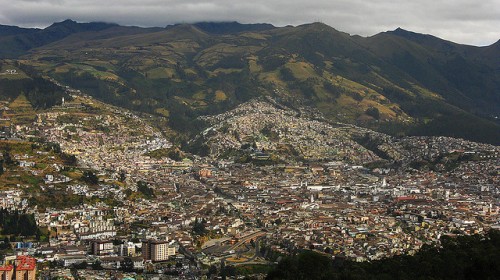
Quito, Ecuador by Orban López Cruz
Jeffrey Stern is a chocolatier, chocolate advocate, entrepreneur, and blogger based in Quito, Ecuador. I recently asked Jeff to answer a long list of questions about his life and work, and he was kind enough to oblige. The first part of the interview can be read here. Below, in the second part of the interview, Jeff presents his views on standards in production, trade certifications, power relations, communication, and sharing in the chocolate world.
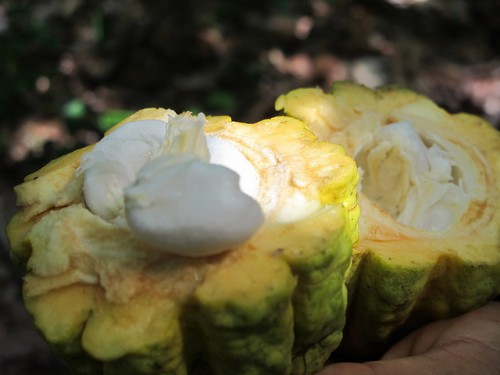
Fresh cacao by Mikko Koponen
Interview with Jeffrey Stern, Part 2, November 2011
Carla Martin (CDM): What standards in chocolate production do you value?
Jeffrey Stern (JM): I guess I’d have to say transparency over all. I’ll have to speak specifically to my situation in Ecuador on this first. I would love to be able to buy all chocolate made from pure Nacional beans for my production, but for both financial reasons and reasons of control, I can’t.
First off, the market here won’t bear a high cost chocolate. For example, I could buy Kallari couverture for all my chocolate making, but at $16 per kilo I’d lose money on everything I make. I just can’t pay that much for chocolate and be able to make money on it here. Unfortunately, we all have to eat.
Second, as I have discussed frequently, I can’t control what the local manufacturers’ choice of beans is and so I can’t know what beans they are using when they make chocolate. I wish I had large enough volume to have custom batches of chocolate made for my own use, but I don’t. So for local production, I buy some couverture at around $6 per kilo. If I had the volume, I’d source beans myself and have the chocolate made per my own specs. But what I buy at the lower end of the price scale is most likely mixed beans (CCN-51 and Nacional).
I do buy some pure Nacional couverture. How do I know it’s pure Nacional? I have a friend who is part owner in two large farms of pure Nacional cacao. I have been to the farms and seen them. He is Swiss, has lived here 30 years, I’ve been doing business with him nearly since I arrived five years ago, and I trust him. He has couverture made in country and sells it to me, among other people, at a fair price.
What’s important to me is to be able to know something, preferably a whole lot, about where my chocolate comes from, how it’s been produced, and what’s in it. I think the links most chocolate manufacturers state they have with the sources of their beans are tenuous at best most of the time, and certifications don’t really interest me as I don’t think they say much. It’s a paradox, but I would say the smaller, artisan chocolatiers are at both an advantage and disadvantage to the big guys. The big buyers can buy a whole farm or cooperative’s production and make a chocolate out of it and call it “Single Estate,” though that doesn’t mean it might not be mixed with other beans. But if they can’t get enough beans from one prime source, they are forced to blend. Economy of scale works both to their advantage and disadvantage. The small, artisan chocolatier can buy beans from just one or two or three prime sources, and can make a different batch of chocolate from each of those sources, which the big players can’t do because of scale problems.
I am not so much concerned with organic, Fair Trade, Rainforest Alliance, or other certifications. Here in Ecuador, to buy chocolate with any kind of certification is unfeasible price-wise for the local market. I think this is an interesting rhetorical question for consumers in the developed world to consider, too — “I can buy this ‘certified’ chocolate in the US, and yet there’s no market for it in the country of origin?” Right there is a topic to ponder.
CDM: How do you aim to share your knowledge about chocolate with others?
JS: I spend a lot of time online trying to blog, advocate, and discuss the issues facing Ecuadorian cacao, as well as many of the technical aspects of chocolate making, confectionery, etc. I don’t really focus on a global level as I don’t consider myself an expert on cacao worldwide — nor on cacao in general. But blogging only gets me so far and to a limited audience. I am hoping to get some video content online as well soon.
Fortunately, after four long and difficult years getting established in Ecuador and building a reputation as a person knowledgeable about chocolate and the industry here, I have been recognized and sought after by local businesses, especially in the travel and tourism area, and internationally. It’s unfortunate that I have to look mainly outside of Ecuador for interest in the ideas I have to share, but again, one has to make a living. I now have offerings with three different tour operators — I’ll be the guide for a four day portion of an eight day tour in February and March of 2012 with Ecuador Jungle Chocolate. The first four days will include visits to chocolate makers in Ecuador, and the second four will be focused on mushrooms with Larry Evans. I am also working with Quasar Nautica and Gentian Trails; we will have offerings of chocolate classes for tour groups, as well as tastings and visits to chocolate factories in Quito. I’ll also be meeting with and helping Sharon Lane as part of a documentary effort about chocolate in Ecuador in December 2011.
CDM: How do you communicate with other chocolate makers and chocolatiers?
JS: Most of the people I know in the chocolate community are extremely open and helpful. I use The Chocolate Life for some communication and information sharing and to help share some of my ideas. But I find my most valuable contacts are direct. Two years ago I had the opportunity to meet with Michael Recchiuti in San Francisco and spent a long Sunday morning with him, asking questions and sharing my experiences in Ecuador. Since then I’ve been fortunate enough to be able to email with him directly on many ocassions. I’ve also reached out to Christopher Elbow in Kansas City and he’s been very helpful. When I visit the US, which is almost every year, I try to take a class or two. Last year I took a class with Patrick Peeters, the head R&D Chef Chocolatier for North America at Godiva. Linkedin is also a great resource. I have been reaching out, expanding, and intensifying my efforts to stay connected with people in the US; even though I may be located in the “center” of the chocolate world in some ways, I often feel very much at the periphery of what’s going on in the world, because, let’s face it, the developed world where the money is drives the trends and shapes what happens with chocolate much more than the producers of cacao do.
I’ve also been extremely fortunate in working with Dana Brewster and Mark DelVecchio of Millcreek Cacao Roasters. They initially came to Ecuador to source cacao, hiring me as their guide. Since then, we’ve developed an excellent working relationship and we are working together on a Kickstarter project to be launched soon.
CDM: How do you understand your role or place in the chocolate world?
JS: My job as a chocolatier I wouldn’t replace for anything. While it’s totally unofficial, because chocolate is universally appreciated, I see myself as sort of an “Ambassador” for Ecuadorian chocolate and the issues surrounding it. Of course, many of the issues facing Ecuadorian cacao growers and the chocolate industry here have similar parallels elsewhere.
This summer I was at a cacao trader’s patio in El Empalme, Ecuador. He obviously moved large quantities of not only cacao, but also rice, coffee, and corn. I asked him if he exported and I was taken aback when he said no; he said he didn’t have the language ability nor the contacts to export. I think there are something like 36 official cacao exporters in Ecuador. Most of them don’t tell anyone much about what they’re doing, their business, or the issues involved. Maybe they’re too busy, they don’t want to, or they’re just not interested. There are also many cooperatives or producers’ associations in Ecuador — some do better than others at getting their stories out there. But in general, the small producer/cooperative/association is pretty much unknown. I would like to be able to remove the veil that covers the cacao trade at the ground level; too much of the business is controlled, both in economic terms and in “story” terms, by the big players and large markets.
I would love to see the day when consumers, through their pocketbooks, have influenced the other end of the cacao chain, especially the buyers, to pay a premium for pure Nacional cacao from Ecuador. A level playing field where Nacional is awarded a premium for its flavor profile and thus is once again more widely grown, despite its lower productivity and lower disease resistance than CCN-51, would be a boon for chocolate connoisseurs worldwide. It would be an amazing day if chocolate lovers worldwide would rise up in outrage like they recently have against Bank of America’s $5 debit card fees or Netflix’s plan changes! Sure, it’s not an exact parallel because these examples are about price hikes consumer don’t want; but if consumers were to respond in a similar fashion about price hikes they think farmers should get for their goods, well, this would be a radical shift in thinking.
CDM: How has travel and living abroad affected your appreciation and understanding of chocolate?
JS: I could never have learned all I know about Ecuadorian cacao and the industry here without having lived here for several years. I would never be able to understand the flavor nuances in chocolate without having tasted chocolate liquors from different farms. Now that I understand just how remote the source of much of the world’s great cacao is, it’s really amazing how it arrives all the way to your store or postbox. It arrives with such ease, and yet there is still such a large disconnect, and in academic speak, market fragmentation, on the ground here in Ecuador. The market mechanisms are broken and connections between cacao producers, cacao traders on the ground here, and cacao exporters are unregulated, unstandardized, and inefficient. This means that most of the time, small producers don’t get a fair price for their cacao, quality is not awarded the premiums it should get, and rare, fine aroma cacao doesn’t get the respect and treatment it deserves.
CDM: Is your fluency in Spanish important to your work?
JS: Without Spanish, which I learned by the way as an AFS Exchange Student to Chile in 1986, I would not be where I am today. Knowing Spanish allows me to communicate directly with everyone I work with, gives me additional business opportunities, and just opens an infinite number of doors to me as both an individual and a business person that weren’t even visible before. I of course use Spanish everyday, and it has allowed me to teach, share, and attract opportunities.
——————————————————————————————————————————–
Visit Jeffrey Stern’s blog here to learn more about his adventures with chocolate just south of the equator, and follow his company Gianduja Chocolate on his website and on Facebook. Also, stay tuned for Part 3 of this interview, as well as further details on Jeff’s upcoming Kickstarter campaign — he is currently working to launch a direct trade project to promote Ecuador’s heritage Nacional cacao and benefit small farmers.
Interview with Jeffrey Stern, chocolatier and chocolate advocate in Quito, Ecuador
Jeffrey Stern is a chocolatier, chocolate advocate, entrepreneur, and blogger based in Quito, Ecuador. I recently asked Jeff to answer a long list of questions about his life and work, and he was kind enough to oblige. Below, in the first half of this interview, Jeff details the missions of his companies and his educational and work background (which, I should note, left him singularly well prepared for his current work). He also explains many of the challenges that small batch production chocolatiers face in relation to direct trade, marketing, and domestic/international bureaucracy, as well as the travel and learning opportunities that forever changed the way he tastes and understands chocolate.
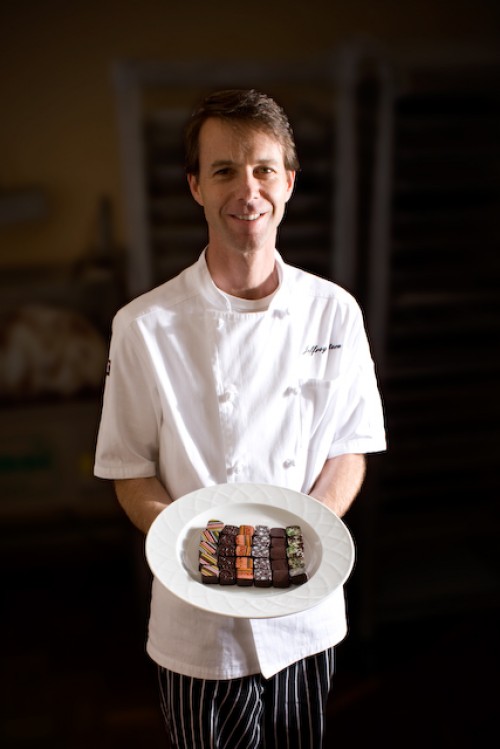
Photo courtesy of Jeffrey Stern
Interview with Jeffrey Stern, Part 1, October 2011
Carla Martin (CDM): What is the focus of your two companies, and what are their missions?
Jeffrey Stern (JS): The focus of my Ecuador based company, Gianduja Chocolate, is to provide high quality, sophisticated bonbons and chocolate products for the local market, using almost all local ingredients. I use only Ecuadorian chocolate, local fruits, cream, and butter, and the only imported items I use are those not available here like transfer sheets, real vanilla, and colored cocoa butters.
My other company, Aequare Fine Chocolates, had as its original mission the goal of importing, wholesaling, and retailing to the United States fine chocolates made in Ecuador with top quality Ecuadorian chocolate. Also, I made it a point of this company to have contact with and knowledge of the chocolate and its origins from bean to final product. I knew the grower of the beans and how he managed his farm, I knew the factory and operations where the chocolate was made, and of course I made the final chocolates myself. We imported into the United States and retailed through the website and worked with a few brokers. Ultimately, the idea was to add value to cacao in the country of origin, and have direct trade relationships with all our suppliers here in Ecuador.
Unfortunately, I think the story was somehow not compelling enough for consumers and what I envisioned as an artisan product being made in Ecuador simply ended up being perceived as another consumer packaged good once it was in the US. Sort of a “lost in translation” problem, as well as the difficulty of explaining a “direct trade” story when you don’t have a multimillion dollar marketing campaign behind the product(s), a big PR budget, etc.
Also, the lack of any US physical presence and someone who could do tastings and trade shows made it difficult to get the product exposure. I think if I had had a physical location somewhere that would have helped a lot. Finally, I see the whole marketing system in the US as such a giant machine, with brokers, distributors, etc. It’s really hard to get your product recognized and noticed, as well as costly if you want to do trade shows. Because the US market and system is so massive, I see it as causing an unfortunate disadvantage for the consumer who, despite the increasing growth and interest in artisan and handmade foods, remains highly disconnected from foods’ origins. And with chocolate, coming all the way from a far off country, it’s even harder to establish and tell a compelling story that offers the authenticity and traceability that consumers often want.
CDM: What are the primary activities of your chocolate and cacao education and training services?
JS: Primarily, I work with companies outside of Ecuador who usually know nothing about the country or the cocoa trade, and want to source either cacao from Ecuador or a semi-processed product such as cacao liquor or powder, or want to have a cacao-based product contract manufactured in Ecuador. I have also worked with artisan bean to bar companies who are looking to source cacao beans from Ecuador. Finally, I act as a “chocolate expert” for chocolate tours — these can be either groups who just have a casual interest in chocolate, or professional groups. I am currently working with three tour operators in Ecuador offering 3-5 day tours centered around chocolate activities, including visits to artisan chocolate makers, visits to plantations, fermentation and drying centers, brokers, and chocolate tastings. I have also been hired to work as a chocolate expert for a well known online chocolate school which will be offering a professional tour in June of next year for chocolatiers and bean to bar chocolate makers.
CDM: How were your companies started?
JS: I moved to Ecuador with my wife and family in May of 2007, with the intention of opening my chocolate business. I had lived in Ecuador from 1994 to 1995, first while getting my Master’s in Community and Regional Planning, and then returned to work for USAID after graduating. I then traveled to Ecuador almost annually until 2007. I got the idea of starting the chocolate business several years after I changed careers (2001, when I attended culinary school). We did some test marketing in trips to Ecuador in 2005 and 2006, and found there was a good market for chocolate. I founded my other company, Aequare, in 2008, with the intention of exporting chocolates from Ecuador. After our first year here, I realized the market wasn’t as big as I had initially expected, and decided to export.
CDM: How are your companies structured, and how many employees work with the companies?
JS: Our local company in Ecuador, Gianduja Chocolate, is a sole proprietorship. I am the chocolatier, my wife takes care of administration and accounting, and I have one employee who knows about 80% of what I do. My other company is an LLC. I am the only employee. When the need arises, I occasionally hire an additional person, but due to very onerous labor laws in Ecuador which make part-time or hourly payment nearly impossible, it’s rare.
CDM: What is your educational background and training?
JS: I have a Bachelor’s in Latin American Studies from New York University and a Master’s Degree in Community and Regional Planning from the University of Texas at Austin. I am also a 2001 graduate of L’Academie de Cuisine in Gaithersburg, Maryland, where I earned a degree in culinary arts.
CDM: What type of work were you involved in before beginning these companies? Was it related to or unrelated to chocolate?
JS: My first career after college and graduate school was primarily in foreign aid; specifically, I spent several years working with USAID based in Ecuador. I also worked with a consulting firm in Washington, DC for one year that was focused primarily on World Bank, Inter-American Development Bank, and USAID projects. I spent two years in Nicaragua working in population and health programs with USAID as well. None of the work was related to chocolate.
After completing my culinary training, I worked in restaurants, catering operations, and as a personal chef. I later worked in a chocolate shop part-time.
CDM: What are some of the challenges that you have encountered while running your businesses?
JS: Ecuador’s environment, both on the private sector side and the public (government) side is all about friction. There seems to be a genuine lack of cooperation — it sounds amusing, but it’s not.
While getting permits and paperwork for operating has gotten a little bit more transparent in recent years, things still seem very arbitrary and ambiguous. It used to be that you had to hire an “expediter” to get almost anything done — that’s doublespeak for someone who you pay to grease the wheels of bureaucracy and issue you permits in a timely fashion. Now you can get many permits directly yourself, but the amount of time and money involved makes it just as costly as if you had hired the expediter.
When you go to an agency, be it the Municipality, the tax agency, the Ministry of Health, you can get one answer one day, and the next day you go back with the same question, and you’ll get an entirely different answer. You get the feeling that nobody really knows the rules, and that they’re being made up as things move along. So you never are really sure if you’re doing things right. It’s very frustrating and unnerving.
On the private sector side, there are difficulties in getting paid. No one uses the mail here, and messenger services only occasionally. Electronic payments are the exception, not the rule. Most companies pay from 2pm-4pm on Friday afternoons at their offices. So if you can’t make it to pick up your check, you have to wait another week to get paid. Fortunately, I have enough business now and a unique product that allows me to have a “cash only — take it or leave it” policy. That is, if you want the product, it’s cash or check on delivery, with few exceptions only for longstanding clients.
There’s very little collaboration or cooperation among similar types of businesses to help each other out. For example, there is no organization or association in Quito of chocolate makers who might attempt to work together for publicity or other ends to grow the market cooperatively for their products. Businesses jealously guard their secrets. I call this an economy of scarcity, not abundance, and thus, because even information is scarce, no one shares it. I think in the long run it’s detrimental to business, and while this is a broad generalization, I think the lack of trust and cooperation is one of the factors that hinders economic growth.
CDM: How do you keep up to date with new developments in chocolate?
JS: I mostly use the web to learn about what is going on in the chocolate world. Here in Ecuador, I have regular contact with people in the cacao and chocolate industry from growers to manufacturers of chocolate and semi-processed products such as liquor and powder. We have recently formed a group of professsional industry people involved in chocolate at all points in the supply chain called the “Academia de Chocolate,” which is another forum for sharing and gathering information.
CDM: Why chocolate? What about it is fascinating to you?
JS: I got interested in chocolate when I started working part-time in a chocolate shop. I hadn’t really gotten a good understanding of how to work with chocolate in culinary school, so I got some books and started to study on my own. There are very few sources that clearly explain what tempering chocolate actually is; when I was finally able to read about the polymorphism of cocoa butter and how temperature affects crystal formation in chocolate, I was able to wrap my head around it. Not only does chocolate taste good, of course, but it’s a fascinating substance to work with.
After almost 5 years in Ecuador in the chocolate business, my knowledge has expanded far beyond just the technical know-how of chocolate making. I have knowledge of bean to bar operations, identifying quality cacao, import/export operations, and how the cacao industry works in Ecuador.
CDM: What was your “aha” moment in relation to chocolate?
JS: I never really understood what chocolate was and how its flavor was developed until I actually went to a plantation and tasted several chocolate liquors (pastes) made on the spot from beans. When I tasted various liquors side by side from beans from different areas, with different fermentation, I suddenly realized just how important the beans are and just how different beans with different fermentations, roasts, etc can be. It was like a light bulb went on in my head — a total epiphany. Now when I taste chocolate I have a much better picture in my head (or taste map, however you’d call it) of what’s good or off about a chocolate’s flavor than I ever did before.
——————————————————————————————————————————–
Visit Jeffrey Stern’s blog here to learn more about his adventures with chocolate just south of the equator, and follow his company Gianduja Chocolate on his website and on Facebook. Also, stay tuned for Part 2 of this interview, as well as details on Jeff’s upcoming Kickstarter campaign — he is currently working to launch a direct trade project to promote Ecuador’s heritage Nacional cacao and benefit small farmers.
Update (November 8, 2011): Part 2 of the interview can be read here.
